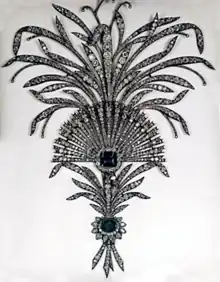The Iranian National Jewels (Persian: جواهرات ملی ایران, Javāherāt-e Melli-ye Irān), originally the Iranian Crown Jewels (Persian: جواهرات سلطنتی ایران, Javāherāt-e Saltanati-ye Irān), include elaborate crowns, thirty tiaras, and numerous aigrettes, a dozen bejeweled swords and shields, a number of unset precious gems, numerous plates and other dining services cast in precious metals and encrusted with gems, and several other more unusual items (such as a large golden globe with the oceans made of emeralds) collected or worn by the Persian monarchs from the 16th century (Safavid Iran) and on. The collection is housed at the Treasury of National Jewels, situated inside the Central Bank of Iran on Tehran's Ferdowsi Street.[1]
Safavid and Afsharid conquests
The majority of the items now in the collection were acquired by the Safavid dynasty, which ruled Iran from 1502 to 1736 AD. Afghans invaded Iran in 1719 and sacked the then capital of Isfahan and took the Iranian crown jewels as plunder. By 1729, however, after an internal struggle of nearly a decade, Nader Shah Afshar successfully drove the Afghans from Iran. In 1738, the Shah launched his own campaign against the Afghan homeland. After taking and raiding the cities of Kandahar and Kabul as well as several principalities in far-off northern India, and sacking Delhi, the victorious Nader Shah returned to Iran with what remained of the plundered crown jewels as well as several other precious objects now found in the Iranian Treasury. These included diamonds, emeralds, rubies, sapphires, and other precious gemstones. Four of the most prominent acquisitions from this conquest were the Koh-i-Noor and Darya-ye Noor diamonds (both originating from India and still amongst the largest in the world), the Peacock Throne, and the Samarian Spinel.
Modern use (Pahlavi dynasty–present)

The crown jewels were last used by the Pahlavi dynasty, the last to rule Iran. The splendor of the collection came to the attention of the western world largely through their use by Mohammad Reza Pahlavi and his Shahbanu, Farah Pahlavi, during official ceremonies and state visits.
The Iranian crown jewels are considered so valuable that they are still used as a reserve to back Iranian currency (and have been used this way by several successive governments). In 1937, during the reign of Reza Shah Pahlavi, ownership of the Imperial treasury was transferred to the state. The jewels were placed in the vaults of the National Bank of Iran, where they were used as collateral to strengthen the financial power of the institution and to back the national monetary system.[2] This important economic role is perhaps one reason why these jewels, undeniable symbols of Iran's monarchic past, have been retained by the current Islamic Republic.
Public display
Because of their great value and economic significance, the Iranian crown jewels were for centuries kept far from public view in the vaults of the Imperial treasury. However, as the first Pahlavi Shah had transferred ownership of the crown jewels to the state, his son, Mohammad Reza Pahlavi, decreed that the most spectacular of the jewels should be put on public display at the Central Bank of Iran.
When the Iranian Revolution toppled the Pahlavi dynasty in 1979, it was feared that in the chaos the Iranian crown jewels had been stolen or sold by the revolutionaries. Although in fact some smaller items were stolen and smuggled across Iran's borders, the bulk of the collection remained intact. This became evident when the revolutionary government under the presidency of Hashemi Rafsanjani re-opened the permanent exhibition of the Iranian crown jewels to the public in the 1990s. They remain on public display.
The Imperial Collection
 The Pahlavi Crown
The Pahlavi Crown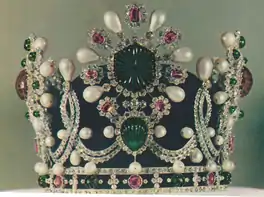 The Empress's Crown
The Empress's Crown Noor-ul-Ain tiara
Noor-ul-Ain tiara_Diamond_from_the_collection_of_the_national_jewels_of_Iran_at_Central_Bank_of_Islamic_Republic_of_Iran.jpg.webp) Daria-i-Noor diamond
Daria-i-Noor diamond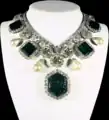 Coronation Necklace
Coronation Necklace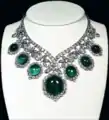 Emerald necklace
Emerald necklace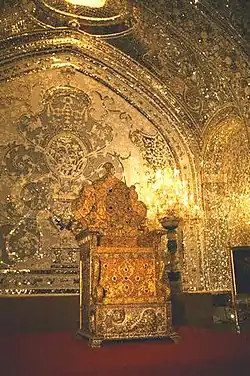 The Naderi Throne
The Naderi Throne Chest filled with pearls
Chest filled with pearls Golden flagon
Golden flagon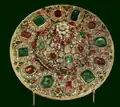 Jeweled dish cover
Jeweled dish cover Coronation Cape
Coronation Cape The Jeweled Globe
The Jeweled Globe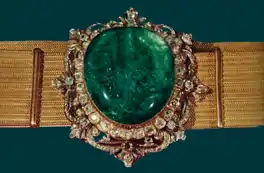 The Golden Belt
The Golden Belt
(Shah's Coronation Belt) The Imperial Sword
The Imperial Sword
The Royal Mace of Iran
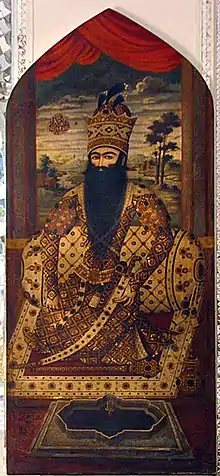
The Royal Mace of Iran is a jewel-encrusted ceremonial mace, a part of the Iranian Crown Jewels. It was a favorite of Fath-Ali Shah Qajar, who is often shown holding it in his miniature portraits. The mace is encrusted with spinels and diamonds, from end to end. It is 73 cm (2.4 ft) long. The largest diamond weighs 17 carats (3.4 g), and is located on the very top of the mace. The largest spinels are the six surrounding the top of the mace, each weighing 40 carats (8 g).
Other items
- Princess Ashraf Ruby Tiara
- Empress Farah Emerald Tiara
- The Sword of Fath-Ali Shah Qajar
- The Great Globe
- The Sun Throne
- Sword of Nader Shah
- Shield of Nader Shah
See also
- Crown jewels
- Treasury of National Jewels
- National Museum of Iran
- Saltmen
- Culture of Iran
- History of Iran
- Tourism in Iran
- Geography of Iran
- International rankings of Iran
- Category:Iranian National Jewels
References
- ↑ "خزانه جواهرات ملی". بانک مرکزی جمهوری اسلامی ايران. Archived from the original on 2017-09-12. Retrieved 2013-09-15.
- ↑ "Iran Chamber Society: Iranian National -Royal- Jewels". Iranchamber.com. 1937-11-16. Archived from the original on 2012-07-16. Retrieved 2012-08-18.
- Malecka, A. "The Mystery of the Nur al-Ayn Diamond", in: Gems & Jewellery: The Gemmological Association of Great Britain vol. 23, no. 6, July 2014, pp. 20–22. https://issuu.com/jeweller/docs/jeweller_g_j__sept_2014_/58
- Malecka, A. "Daryā-ye Nur: History and Myth of a Crown Jewel of Iran", Iranian Studies vol. 51 (2018), https://dx.doi.org/10.1080/00210862.2017.1362952
- Meen, V.B, Tushingham, A.D. Crown jewels of Iran, Toronto 1968.
External links
 Media related to Crown jewels of Iran at Wikimedia Commons
Media related to Crown jewels of Iran at Wikimedia Commons- Treasury of National Jewels Archived 2014-02-26 at the Wayback Machine
- Amazing Iran
- Iran Crown Jewels with Photos
- Imperial Iran of the Pahlavi Dynasty
- The Imperial Jewels of Iran (images)
- Treasury of National Jewels of Iran Archived 2021-09-26 at the Wayback Machine
- Sara Mashayekh, The Breathtaking Jewelry Museum of Iran, Rozaneh Magazine, January–February 2006,.
- crown jewels of Iran(book)
